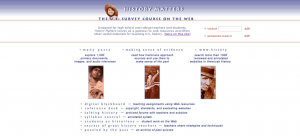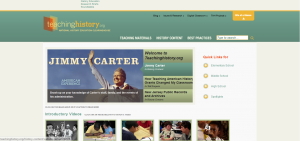Over the past week we have been looking at the various generations of educational websites produced by CHNM. The first of these comprehensive sites, History Matters, hit the web in 1998, and obviously there have been major technical improvements in content management and design since then. Rather than talk about these developments, I want to discuss the way that the focus of the educational websites has evolved.
The first CHNM educational site, History Matters, was an extremely ambitious project. Billed as the comprehensive US history survey site on the web, History Matters was meant as a resource for teachers and students. The site includes a collection of primary documents, games for students, lesson plans, syllabi, and interviews with exceptional teachers.
Who is the target audience of HM? I see at least 3 or 4 potential groups – students browsing for sources, students following a teacher-directed lesson, teachers looking for online lesson plans, and new/pre-service teachers learning to incorporate technology into their classroom. That is quite a crowd to satisfy in one hand-written website.
The newer incarnation of HM, Teaching History, represents a much narrower focus. Unlike HM, Teaching History is designed specifically for teachers, with a combination of resources, plans, and advice. The main page’s left sidebar features quick links for teachers of varying age groups, and the helpful ‘site at a glance’ pop-up shows a complete site map.
Teaching History improves upon History Matters by streamlining the site and narrowing the focus to teaching-only. As a consequence of this narrowing, the site does not include resources for students, but in any case it has proven difficult to encourage student web-research outside of google or wikipedia.
Another CHNM site with a targeted focus is Historical Thinking Matters. Unlike History Matters and Teaching History, which host a large number of documents and resources, Historical Thinking Matters features a small amount of content designed to teach a particular skill set. Through a set of four modules (all of which fall within common curricula) the site leads students through activities that identify and exercise historical skills.
Historical thinking matters is appealing to students for several reasons – it features multimedia, it is light on text, and its modules can be completed fairly quickly. As a resource for teachers, it works well to supplement existing textbooks rather than supplant them. And while the historical scope of the site is narrow, the pedagogical aims (teaching historical meta-cognition) are ambitious and important.
An educational site, like any other, needs to target its audience. To avoid navigation problems and improve usability, this may well mean limiting that target audience. In other words, focus goals and informational architecture need to be well-defined. Teaching History and, especially, Historical Thinking Matters are good examples of this focusing.


